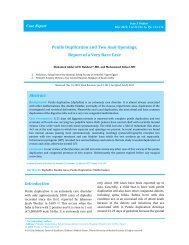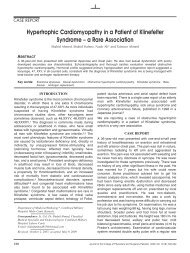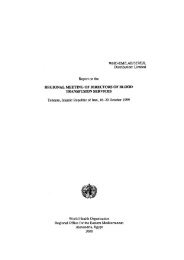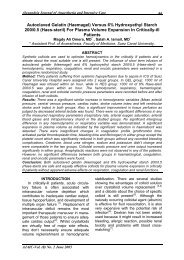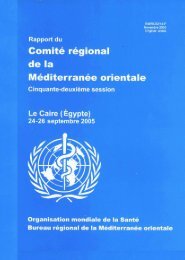Tobacco use in shisha: Studies on waterpipe smoking
Tobacco use in shisha: Studies on waterpipe smoking
Tobacco use in shisha: Studies on waterpipe smoking
You also want an ePaper? Increase the reach of your titles
YUMPU automatically turns print PDFs into web optimized ePapers that Google loves.
Many <strong>waterpipe</strong> smokers (57%) have a misc<strong>on</strong>cepti<strong>on</strong> that it is less harmful than cigarette<br />
smok<str<strong>on</strong>g>in</str<strong>on</strong>g>g. Even those who do not th<str<strong>on</strong>g>in</str<strong>on</strong>g>k this way reported that <strong>waterpipe</strong> smok<str<strong>on</strong>g>in</str<strong>on</strong>g>g decreases the<br />
amount of cigarette c<strong>on</strong>sumpti<strong>on</strong> (Figure 4.11). Most of the participants showed respect for<br />
n<strong>on</strong>smok<str<strong>on</strong>g>in</str<strong>on</strong>g>g areas (Figure 4.12).<br />
The changes <str<strong>on</strong>g>in</str<strong>on</strong>g> <str<strong>on</strong>g>in</str<strong>on</strong>g>dividual smok<str<strong>on</strong>g>in</str<strong>on</strong>g>g patterns reported am<strong>on</strong>g rural Egyptian smokers were<br />
mostly m<str<strong>on</strong>g>in</str<strong>on</strong>g>imal (Figure 4.13).<br />
Quitt<str<strong>on</strong>g>in</str<strong>on</strong>g>g <strong>waterpipe</strong> smok<str<strong>on</strong>g>in</str<strong>on</strong>g>g am<strong>on</strong>g rural Egyptians<br />
Most of the smokers <str<strong>on</strong>g>in</str<strong>on</strong>g>terviewed were will<str<strong>on</strong>g>in</str<strong>on</strong>g>g to quit (Figure 4.14). Many of them stated<br />
that they could quit whenever they wanted (Figure 4.15). However, <strong>on</strong>ly a few had tried to quit<br />
dur<str<strong>on</strong>g>in</str<strong>on</strong>g>g the year before the study (Figure 4.16). The most comm<strong>on</strong> reas<strong>on</strong> for quitt<str<strong>on</strong>g>in</str<strong>on</strong>g>g smok<str<strong>on</strong>g>in</str<strong>on</strong>g>g<br />
was to improve health.<br />
Most of the smokers <str<strong>on</strong>g>in</str<strong>on</strong>g>terviewed who had attempted to quit reported that they had received<br />
help. It was ma<str<strong>on</strong>g>in</str<strong>on</strong>g>ly provided by a family member (Table 4.1)<br />
%<br />
50.0<br />
40.0<br />
30.0<br />
20.0<br />
10.0<br />
0.0<br />
Cigarette<br />
Waterpipe<br />
Both<br />
No Yes Not sure<br />
Figure 4.15 Perceived ability to quit<br />
smok<str<strong>on</strong>g>in</str<strong>on</strong>g>g am<strong>on</strong>g rural Egyptians<br />
%<br />
70.0<br />
60.0<br />
50.0<br />
40.0<br />
30.0<br />
20.0<br />
10.0<br />
0.0<br />
0<br />
Cigarette<br />
Waterpipe<br />
Both<br />
1 2 3+<br />
Number of trials dur<str<strong>on</strong>g>in</str<strong>on</strong>g>g last year<br />
Figure 4.16 Smok<str<strong>on</strong>g>in</str<strong>on</strong>g>g quitt<str<strong>on</strong>g>in</str<strong>on</strong>g>g<br />
attempts am<strong>on</strong>g rural Egyptians<br />
45



